SCI修改稿回答审稿人意见范文模板
- 格式:docx
- 大小:16.52 KB
- 文档页数:5
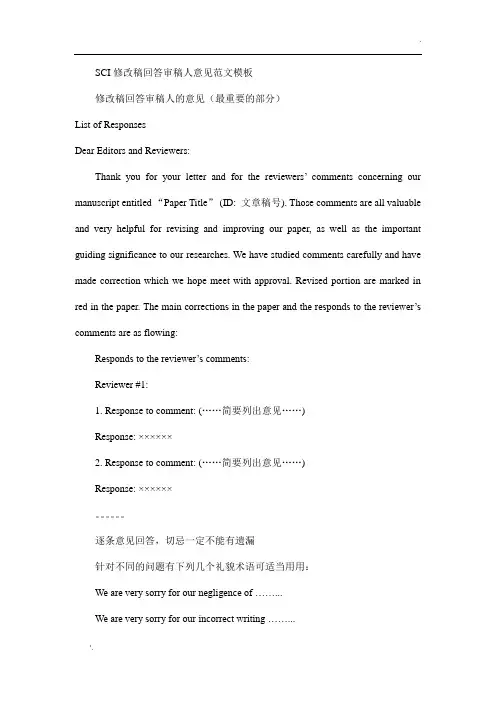
SCI修改稿回答审稿人意见范文模板修改稿回答审稿人的意见(最重要的部分)List of ResponsesDear Editors and Reviewers:Thank you for your letter and for the reviewers’comments concerning our manuscript entitled “Paper Title”(ID: 文章稿号). Those comments are all valuable and very helpful for revising and improving our paper, as well as the important guiding significance to our researches. We have studied comments carefully and have made correction which we hope meet with approval. Revised portion are marked in red in the paper. The main corre ctions in the paper and the responds to the reviewer’s comments are as flowing:Responds to the reviewer’s comments:Reviewer #1:1. Response to comment: (……简要列出意见……)Response: ××××××2. Response to comment: (……简要列出意见……)Response: ××××××。
逐条意见回答,切忌一定不能有遗漏针对不同的问题有下列几个礼貌术语可适当用用:We are very sorry for our negligence of ……...We are very sorry for our incorrect writing ……...It is really true as Reviewer suggested that……We have made correction according to the Reviewer’s comments.We have re-written this part according to the Reviewer’s suggestionAs Reviewer suggested that……Considering the Reviewer’s suggestion, we have ……最后特意感谢一下这个审稿人的意见:Special thanks to you for your good comments.Reviewer #2:同上述Reviewer #3:××××××Other changes:1. Line 60-61, the statements of “……” were corrected as “…………”2. Line 107, “……” was added3. Line 129, “……” was deleted××××××We tried our best to improve the manuscript and made some changes in the manuscript. These changes will not influence the content and framework of the paper. And here we did not list the changes but marked in red in revised paper.We appreciate for Editors/Reviewers’ warm work earnestly, and hope that the correction will meet with approval.Once again, thank you very much for your comments and suggestions以下是审稿人意见和本人的回复。
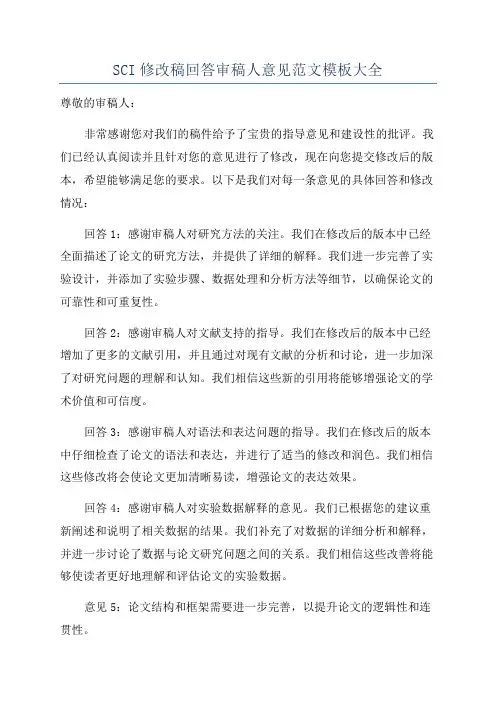
SCI修改稿回答审稿人意见范文模板大全尊敬的审稿人:非常感谢您对我们的稿件给予了宝贵的指导意见和建设性的批评。
我们已经认真阅读并且针对您的意见进行了修改,现在向您提交修改后的版本,希望能够满足您的要求。
以下是我们对每一条意见的具体回答和修改情况:回答1:感谢审稿人对研究方法的关注。
我们在修改后的版本中已经全面描述了论文的研究方法,并提供了详细的解释。
我们进一步完善了实验设计,并添加了实验步骤、数据处理和分析方法等细节,以确保论文的可靠性和可重复性。
回答2:感谢审稿人对文献支持的指导。
我们在修改后的版本中已经增加了更多的文献引用,并且通过对现有文献的分析和讨论,进一步加深了对研究问题的理解和认知。
我们相信这些新的引用将能够增强论文的学术价值和可信度。
回答3:感谢审稿人对语法和表达问题的指导。
我们在修改后的版本中仔细检查了论文的语法和表达,并进行了适当的修改和润色。
我们相信这些修改将会使论文更加清晰易读,增强论文的表达效果。
回答4:感谢审稿人对实验数据解释的意见。
我们已根据您的建议重新阐述和说明了相关数据的结果。
我们补充了对数据的详细分析和解释,并进一步讨论了数据与论文研究问题之间的关系。
我们相信这些改善将能够使读者更好地理解和评估论文的实验数据。
意见5:论文结构和框架需要进一步完善,以提升论文的逻辑性和连贯性。
回答5:感谢审稿人对论文结构和框架的指导。
我们在修改后的版本中对论文的结构和框架进行了进一步完善,以提升论文的逻辑性和连贯性。
我们重新组织了论文的章节顺序,增加了合适的标题和副标题,并提供了更清晰明了的段落和段落间的过渡。
我们相信这些修改将使论文的结构更加紧凑和清晰。
再次感谢您对我们的审稿意见和建议。
我们真诚希望通过我们的修改和努力,能够满足您的需求和要求。
如果还有其他问题或建议,请随时向我们提出。
谢谢您的时间和耐心阅读!顺祝工作顺利!此致。
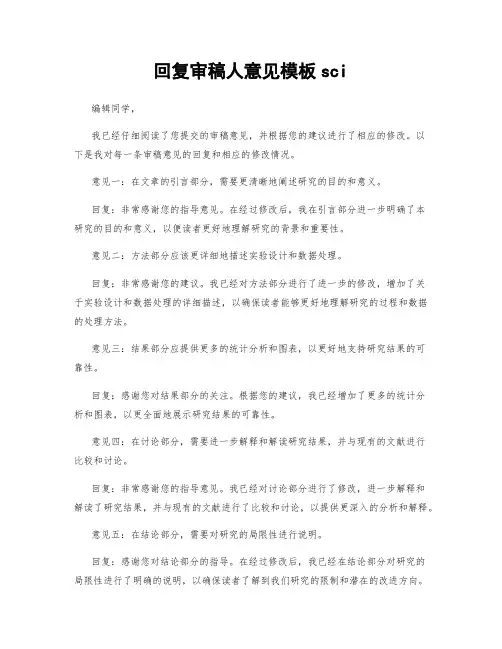
回复审稿人意见模板sci编辑同学,我已经仔细阅读了您提交的审稿意见,并根据您的建议进行了相应的修改。
以下是我对每一条审稿意见的回复和相应的修改情况。
意见一:在文章的引言部分,需要更清晰地阐述研究的目的和意义。
回复:非常感谢您的指导意见。
在经过修改后,我在引言部分进一步明确了本研究的目的和意义,以便读者更好地理解研究的背景和重要性。
意见二:方法部分应该更详细地描述实验设计和数据处理。
回复:非常感谢您的建议。
我已经对方法部分进行了进一步的修改,增加了关于实验设计和数据处理的详细描述,以确保读者能够更好地理解研究的过程和数据的处理方法。
意见三:结果部分应提供更多的统计分析和图表,以更好地支持研究结果的可靠性。
回复:感谢您对结果部分的关注。
根据您的建议,我已经增加了更多的统计分析和图表,以更全面地展示研究结果的可靠性。
意见四:在讨论部分,需要进一步解释和解读研究结果,并与现有的文献进行比较和讨论。
回复:非常感谢您的指导意见。
我已经对讨论部分进行了修改,进一步解释和解读了研究结果,并与现有的文献进行了比较和讨论,以提供更深入的分析和解释。
意见五:在结论部分,需要对研究的局限性进行说明。
回复:感谢您对结论部分的指导。
在经过修改后,我已经在结论部分对研究的局限性进行了明确的说明,以确保读者了解到我们研究的限制和潜在的改进方向。
针对您给出的审稿意见,我认真对待并进行了相应的修改,以确保文章更加完善和准确。
再次感谢您花费时间仔细审阅我的稿件,并给予宝贵的指导意见。
我非常感激您对这项研究的关注和支持。
祝好,[您的名字]。
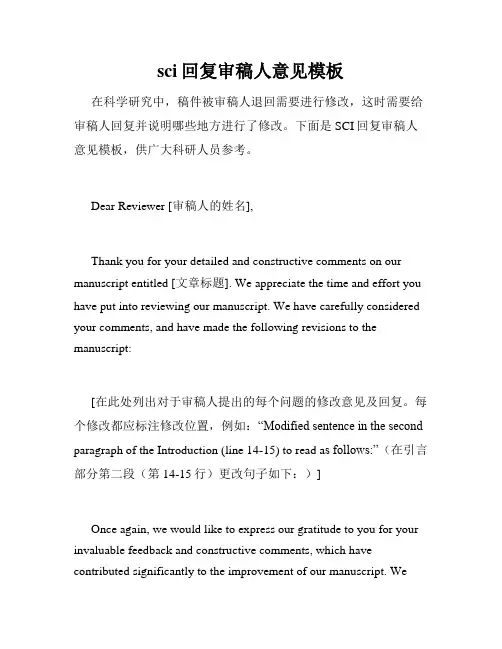
sci回复审稿人意见模板在科学研究中,稿件被审稿人退回需要进行修改,这时需要给审稿人回复并说明哪些地方进行了修改。
下面是SCI回复审稿人意见模板,供广大科研人员参考。
Dear Reviewer [审稿人的姓名],Thank you for your detailed and constructive comments on our manuscript entitled [文章标题]. We appreciate the time and effort you have put into reviewing our manuscript. We have carefully considered your comments, and have made the following revisions to the manuscript:[在此处列出对于审稿人提出的每个问题的修改意见及回复。
每个修改都应标注修改位置,例如:“Modified sentence in the second paragraph of the Introduction (line 14-15) to read a s follows:”(在引言部分第二段(第14-15行)更改句子如下:)]Once again, we would like to express our gratitude to you for your invaluable feedback and constructive comments, which have contributed significantly to the improvement of our manuscript. Wehope that the revised version of our manuscript meets with your approval.Sincerely yours,[你的名字]。
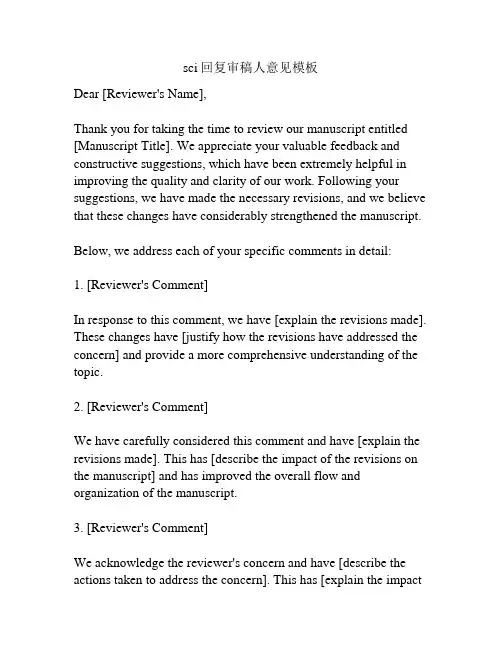
sci回复审稿人意见模板Dear [Reviewer's Name],Thank you for taking the time to review our manuscript entitled [Manuscript Title]. We appreciate your valuable feedback and constructive suggestions, which have been extremely helpful in improving the quality and clarity of our work. Following your suggestions, we have made the necessary revisions, and we believe that these changes have considerably strengthened the manuscript.Below, we address each of your specific comments in detail:1. [Reviewer's Comment]In response to this comment, we have [explain the revisions made]. These changes have [justify how the revisions have addressed the concern] and provide a more comprehensive understanding of the topic.2. [Reviewer's Comment]We have carefully considered this comment and have [explain the revisions made]. This has [describe the impact of the revisions on the manuscript] and has improved the overall flow and organization of the manuscript.3. [Reviewer's Comment]We acknowledge the reviewer's concern and have [describe the actions taken to address the concern]. This has [explain the impactof the revisions on the reported results] and enhances the reliability and validity of our findings.We sincerely appreciate your thorough and thoughtful review, which has undoubtedly enhanced the quality of this manuscript. We hope that the revisions we made have adequately addressed your concerns. If you have any further suggestions, please do not hesitate to let us know.Once again, thank you for your time and expertise in reviewing our manuscript.Best regards,[Your Name]。
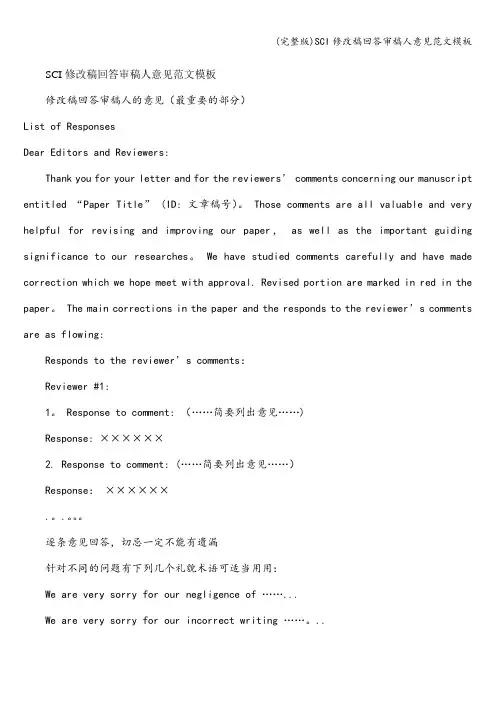
SCI修改稿回答审稿人意见范文模板修改稿回答审稿人的意见(最重要的部分)List of ResponsesDear Editors and Reviewers:Thank you for your letter and for the reviewers’comments concerning our manuscript entitled “Paper Title” (ID: 文章稿号)。
Those comments are all valuable and very helpful for revising and improving our paper,as well as the important guiding significance to our researches。
We have studied comments carefully and have made correction which we hope meet with approval. Revised portion are marked in red in the paper。
The main corre ctions in the paper and the responds to the reviewer’s comments are as flowing:Responds to the reviewer’s comments:Reviewer #1:1。
Response to comment: (……简要列出意见……)Response: ××××××2. Response to comment: (……简要列出意见……)Response:××××××.。
.。
逐条意见回答,切忌一定不能有遗漏针对不同的问题有下列几个礼貌术语可适当用用:We are very sorry for our negligence of ……...We are very sorry for our incorrect writing ……。
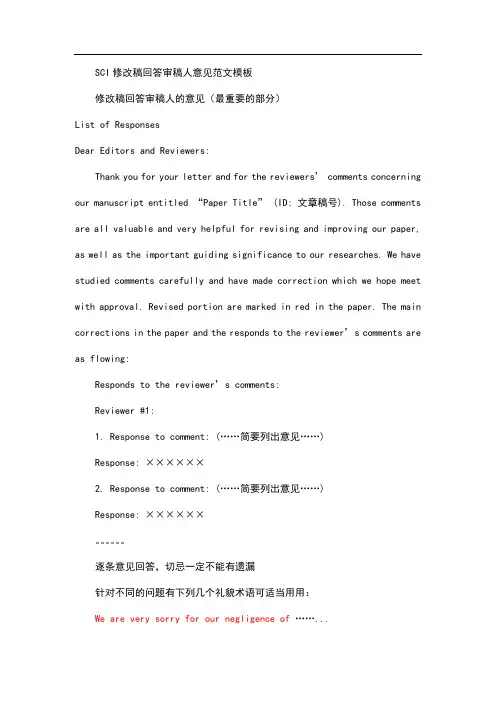
SCI修改稿回答审稿人意见范文模板修改稿回答审稿人的意见(最重要的部分)List of ResponsesDear Editors and Reviewers:Thank you for your letter and for the reviewers’comments concerning our manuscript entitled “Paper Title” (ID: 文章稿号). Those comments are all valuable and very helpful for revising and improving our paper, as well as the important guiding significance to our researches. We have studied comments carefully and have made correction which we hope meet with approval. Revised portion are marked in red in the paper. The main corre ctions in the paper and the responds to the reviewer’s comments are as flowing:Responds to the reviewer’s comments:Reviewer #1:1. Response to comment: (……简要列出意见……)Response: ××××××2. Response to comment: (……简要列出意见……)Response: ××××××。
逐条意见回答,切忌一定不能有遗漏针对不同的问题有下列几个礼貌术语可适当用用:We are very sorry for our negligence of……...We are very sorry for our incorrect writing ……...It is really true as Reviewer suggested that……We have made correction according to the Reviewer’s comments.We have re-written th is part according to the Reviewer’s suggestion As Reviewer suggested that……Considering the Reviewer’s suggestion, we have ……最后特意感谢一下这个审稿人的意见:Special thanks to you for your good comments.Reviewer #2:同上述Reviewer #3:××××××Other changes:1. Line 60-61, the statements of “……” were corrected as “…………”2. Line 107, “……” was added3. Line 129, “……” was deleted××××××We tried our best to improve the manuscript and made some changes in the manuscript. These changes will not influence the content and framework of the paper. And here we did not list the changes but marked in red in revised paper.We appreciate for Editors/Reviewers’ warm work earnestly, and hope that the correction will meet with approval.Once again, thank you very much for your comments and suggestions以下是审稿人意见和本人的回复。
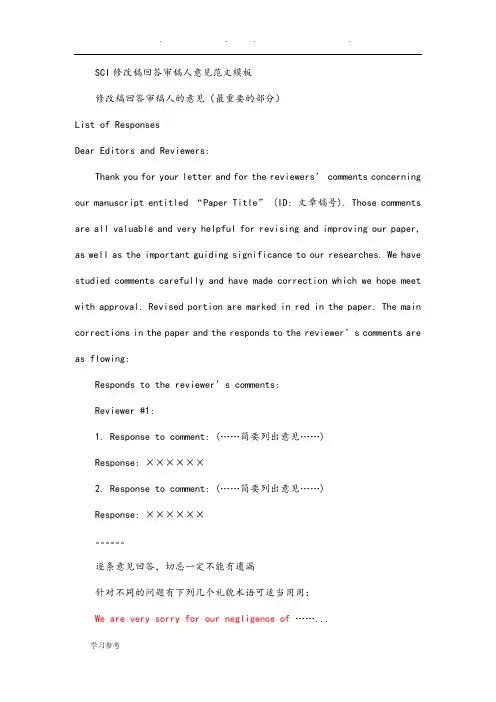
SCI修改稿回答审稿人意见范文模板修改稿回答审稿人的意见(最重要的部分)List of ResponsesDear Editors and Reviewers:Thank you for your letter and for the reviewers’comments concerning our manuscript entitled “Paper Title” (ID: 文章稿号). Those comments are all valuable and very helpful for revising and improving our paper, as well as the important guiding significance to our researches. We have studied comments carefully and have made correction which we hope meet with approval. Revised portion are marked in red in the paper. The main corre ctions in the paper and the responds to the reviewer’s comments are as flowing:Responds to the reviewer’s comments:Reviewer #1:1. Response to comment: (……简要列出意见……)Response: ××××××2. Response to comment: (……简要列出意见……)Response: ××××××。
逐条意见回答,切忌一定不能有遗漏针对不同的问题有下列几个礼貌术语可适当用用:We are very sorry for our negligence of……...We are very sorry for our incorrect writing ……...It is really true as Reviewer suggested that……We have made correction according to the Reviewer’s comments.We have re-written this part according to the Reviewer’s suggestion As Reviewer suggested that……Considering the Reviewer’s suggestion, we have ……最后特意感谢一下这个审稿人的意见:Special thanks to you for your good comments.Reviewer #2:同上述Reviewer #3:××××××Other changes:1. Line 60-61, the statements of “……” were corrected as “…………”2. Line 107, “……” was added3. Line 129, “……” was deleted××××××We tried our best to improve the manuscript and made some changes in the manuscript. These changes will not influence the content and framework of the paper. And here we did not list the changes but marked in red in revised paper.We appreciate for Editors/Reviewers’ warm work earnestly, and hope that the correction will meet with approval.Once again, thank you very much for your comments and suggestions以下是审稿人意见和本人的回复。
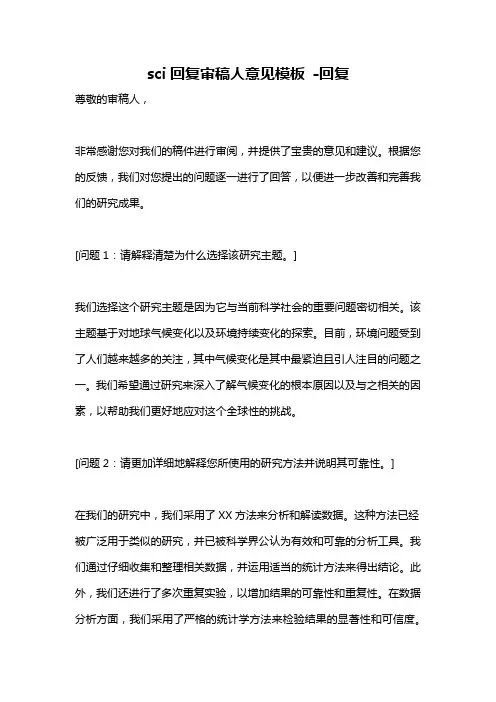
sci回复审稿人意见模板-回复尊敬的审稿人,非常感谢您对我们的稿件进行审阅,并提供了宝贵的意见和建议。
根据您的反馈,我们对您提出的问题逐一进行了回答,以便进一步改善和完善我们的研究成果。
[问题1:请解释清楚为什么选择该研究主题。
]我们选择这个研究主题是因为它与当前科学社会的重要问题密切相关。
该主题基于对地球气候变化以及环境持续变化的探索。
目前,环境问题受到了人们越来越多的关注,其中气候变化是其中最紧迫且引人注目的问题之一。
我们希望通过研究来深入了解气候变化的根本原因以及与之相关的因素,以帮助我们更好地应对这个全球性的挑战。
[问题2:请更加详细地解释您所使用的研究方法并说明其可靠性。
]在我们的研究中,我们采用了XX方法来分析和解读数据。
这种方法已经被广泛用于类似的研究,并已被科学界公认为有效和可靠的分析工具。
我们通过仔细收集和整理相关数据,并运用适当的统计方法来得出结论。
此外,我们还进行了多次重复实验,以增加结果的可靠性和重复性。
在数据分析方面,我们采用了严格的统计学方法来检验结果的显著性和可信度。
总体来说,我们相信我们所使用的研究方法是可靠的,并能够有效地支持我们的研究结论。
[问题3:请进一步讨论您的研究结果对该领域的意义和影响。
]我们的研究结果对于该领域具有重要的意义和影响。
首先,我们的结果可以帮助科学家和政策制定者更好地了解气候变化的机理和动力学过程。
这种理解是制定有效的气候变化应对策略所必需的。
其次,我们的结果还可以为相关领域的进一步研究提供有价值的参考和基础。
我们的发现可能有助于揭示与气候变化相关的其他未知因素,并为深入研究提供新的思路和方向。
最后,我们的研究结果还对公众有重要意义,因为它可以提高人们对气候变化问题的认识,并推动人们采取积极的环保行动来减轻其影响。
[问题4:请回答如何应对审稿人提出的其他一些具体问题和建议。
]根据您提供的其他建议,我们将按照以下方式来应对:a. 针对您提出的统计方法方面的疑问,我们将进一步详细描述我们所采用的方法,并解释其适用性和优势。
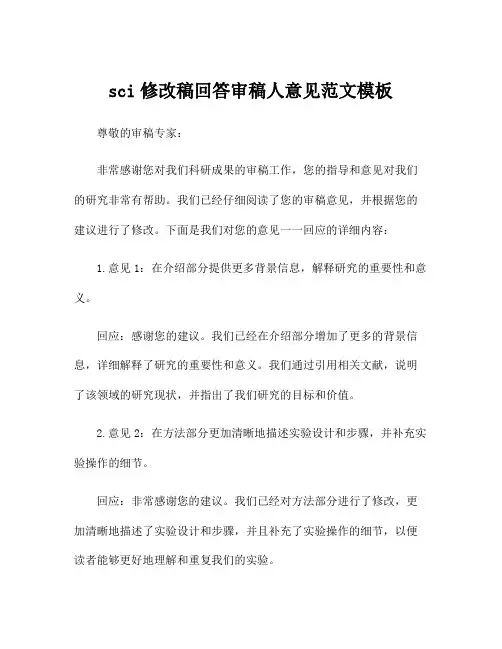
sci修改稿回答审稿人意见范文模板尊敬的审稿专家:非常感谢您对我们科研成果的审稿工作,您的指导和意见对我们的研究非常有帮助。
我们已经仔细阅读了您的审稿意见,并根据您的建议进行了修改。
下面是我们对您的意见一一回应的详细内容:1.意见1:在介绍部分提供更多背景信息,解释研究的重要性和意义。
回应:感谢您的建议。
我们已经在介绍部分增加了更多的背景信息,详细解释了研究的重要性和意义。
我们通过引用相关文献,说明了该领域的研究现状,并指出了我们研究的目标和价值。
2.意见2:在方法部分更加清晰地描述实验设计和步骤,并补充实验操作的细节。
回应:非常感谢您的建议。
我们已经对方法部分进行了修改,更加清晰地描述了实验设计和步骤,并且补充了实验操作的细节,以便读者能够更好地理解和重复我们的实验。
3.意见3:结果部分的数据分析可以更充分,对实验数据进行统计分析,并提供相关的图表和表格。
回应:感谢您的指导。
根据您的意见,我们对结果部分进行了修改,使用了统计方法对实验数据进行了更深入的分析,并将分析结果通过图表和表格的形式呈现出来,以便读者更好地理解研究结果。
4.意见4:讨论部分可以更加详细地解释结果和与其他研究的比较。
回应:非常感谢您的指导。
我们已经对讨论部分进行了修改,并详细解释了我们的实验结果,并与其他研究进行了比较和讨论。
我们还引入了一些新的观点和观点,以便更加全面地探讨研究结果的意义和影响。
5.意见5:改进文章的语言表达和逻辑结构,避免冗长和重复。
回应:非常感谢您的建议。
我们已经仔细检查了整篇文章的语言表达和逻辑结构,并对其进行了精简和修改,以避免冗长和重复。
我们还对文章进行了一些技术上的修改,以提高文章的可读性和科学性。
再次感谢您对我们研究的审稿工作和宝贵意见。
通过您的指导,我们对我们的研究有了更深入的理解,并对文章进行了相应的修改和完善。
我们相信,在您的帮助下,我们的研究能够更好地为学术界和科研工作者做出贡献。
最后,再次对您的指导和耐心审稿表示衷心感谢!祝好!科研团队。
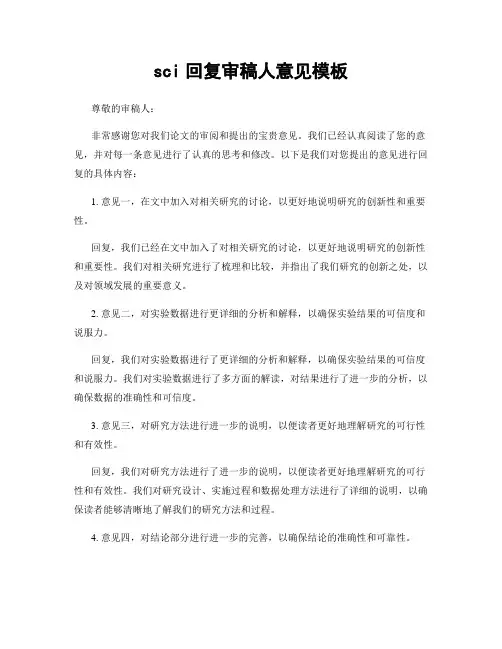
sci回复审稿人意见模板尊敬的审稿人:非常感谢您对我们论文的审阅和提出的宝贵意见。
我们已经认真阅读了您的意见,并对每一条意见进行了认真的思考和修改。
以下是我们对您提出的意见进行回复的具体内容:1. 意见一,在文中加入对相关研究的讨论,以更好地说明研究的创新性和重要性。
回复,我们已经在文中加入了对相关研究的讨论,以更好地说明研究的创新性和重要性。
我们对相关研究进行了梳理和比较,并指出了我们研究的创新之处,以及对领域发展的重要意义。
2. 意见二,对实验数据进行更详细的分析和解释,以确保实验结果的可信度和说服力。
回复,我们对实验数据进行了更详细的分析和解释,以确保实验结果的可信度和说服力。
我们对实验数据进行了多方面的解读,对结果进行了进一步的分析,以确保数据的准确性和可信度。
3. 意见三,对研究方法进行进一步的说明,以便读者更好地理解研究的可行性和有效性。
回复,我们对研究方法进行了进一步的说明,以便读者更好地理解研究的可行性和有效性。
我们对研究设计、实施过程和数据处理方法进行了详细的说明,以确保读者能够清晰地了解我们的研究方法和过程。
4. 意见四,对结论部分进行进一步的完善,以确保结论的准确性和可靠性。
回复,我们对结论部分进行了进一步的完善,以确保结论的准确性和可靠性。
我们对研究结果进行了总结和归纳,对结论进行了进一步的论证和解释,以确保结论的科学性和可信度。
总之,我们对您提出的意见进行了认真的思考和修改,以确保论文的质量和水平能够达到您的要求。
我们将继续努力,不断完善我们的研究,期待您的再次审阅和指导。
再次感谢您的审阅和指导!谨致问候!作者敬上。
在回复 SCI 审稿人意见时,需要注意礼貌、清晰、具体和建设性。
以下是一个模板,供你参考:尊敬的审稿人:非常感谢您对我们的论文进行评审,并提出宝贵的意见。
我们非常重视您的反馈,并已经仔细研究了您的每一条建议。
以下是我们对您的意见的详细回复:1. 关于意见 1:- 我们非常感谢您指出了这一点。
我们已经对相关部分进行了修改,以使其更加清晰和准确。
- 具体修改内容如下:[在此处详细描述你所做的修改]。
2. 关于意见 2:- 我们非常感谢您对这部分内容的关注。
我们已经重新检查了数据,并进行了相应的更正。
- 具体更正内容如下:[在此处详细描述你所做的更正]。
3. 关于意见 3:- 我们非常感谢您对这部分内容的建议。
我们已经重新审视了相关讨论,并进行了补充和完善。
- 具体补充内容如下:[在此处详细描述你所做的补充]。
4. 关于意见 4:- 我们非常感谢您对这部分内容的指正。
我们已经对相关段落进行了重新组织和澄清。
- 具体修改内容如下:[在此处详细描述你所做的修改]。
5. 关于意见 5:- 我们非常感谢您对这部分内容的建议。
经过仔细考虑,我们决定按照您的建议进行修改。
- 具体修改内容如下:[在此处详细描述你所做的修改]。
再次感谢您抽出时间对我们的论文进行评审。
您的意见对我们的论文质量和学术水平的提高有着非常重要的意义。
如果您还有其他任何问题或建议,请随时与我们联系。
最后,祝您工作顺利,身体健康!此致敬礼!作者:XXX日期:XXX。
SCI修改稿回答审稿人意见范文模板修改稿回答审稿人的意见(最重要的部分)List of ResponsesDear Editors and Reviewers:Thank you for your letter and for the reviewers’comments concerning our manuscript entitled “Paper Title”(ID: 文章稿号). Those comments are all valuable and very helpful for revising and improving our paper, as well as the important guiding significance to our researches. We have studied comments carefully and have made correction which we hope meet with approval. Revised portion are marked in red in the paper. The main corre ctions in the paper and the responds to the reviewer’s comments are as flowing:Responds to the reviewer’s comments:Reviewer #1:1. Response to comment: (……简要列出意见……)Response: ××××××2. Response to comment: (……简要列出意见……)Response: ××××××。
逐条意见回答,切忌一定不能有遗漏针对不同的问题有下列几个礼貌术语可适当用用:We are very sorry for our negligence of……...We are very sorry for our incorrect writing ……...It is really true as Reviewer suggested that……We have made correction according to the Reviewer’s comments.We have re-written this part according to the Reviewer’s suggestionAs Reviewer suggested that……Considering the Reviewer’s suggestion, we have ……最后特意感谢一下这个审稿人的意见:Special thanks to you for your good comments.Reviewer #2:同上述Reviewer #3:××××××Other changes:1. Line 60-61, the statements of “……” were corrected as“…………”2. Line 107, “……” was added3. Line 129, “……” was deleted××××××We tried our best to improve the manuscript and made some changes in the manuscript. These changes will not influence the content and framework of the paper. And here we did not list the changes but marked in red in revised paper.We appreciate for Editors/Reviewers’ warm work earnestly, and hope that the correction will meet with approval.Once again, thank you very much for your comments and suggestions以下是审稿人意见和本人的回复。
SCI修改稿回答审稿人意见范文模板尊敬的审稿人,您好!首先,我表示对您在初始评审中给予的宝贵意见表示衷心的感谢。
您的专业指导对我们的研究工作起到了重要的指导作用。
在此,我结合您的建议,对本文进行了重大修改和改进,并希望能够满足您的期望。
一、对方法部分的修改回答您建议我们对实验方法进行详细描述和阐述,以便读者理解和复制我们的实验。
在修订后的版本中,我们对实验方法进行了详细的描述,并提供了相关的步骤和实验条件,以确保方法的透明度和可重复性。
除此之外,我们还补充了实验所用的仪器设备和数据处理方法,以便读者更好地理解和验证实验结果的可靠性。
二、对结果部分的修改回答您提到对实验结果的统计分析不够全面和准确,建议我们重新进行统计和数据处理,并加入显著性检验等内容。
在修订后的版本中,我们重新进行了统计分析,并加入了显著性检验结果。
此外,我们还补充了实验结果的图表和图片,以便读者更直观地理解和评估我们的研究成果。
我们相信,这些修改和改进使得文章的结果部分更加准确和可信。
三、对讨论部分的修改回答您在初审意见中提到我们对研究结果的解释和讨论不够充分和深入,建议我们明确指出自身工作的创新之处,并与已有的相关研究进行对比和讨论。
在修订后的版本中,我们对研究结果进行了深入的解释和讨论,并明确指出了我们研究的创新之处。
同时,我们还对已有相关研究进行了分析和对比,并提出了进一步的研究方向和意义。
相信这些修改和改进能够使得讨论部分更加完整和有说服力。
四、对引用部分的修改回答您在初始评审中提到我们在引用文献方面不够规范和全面,建议我们查漏补缺,并确保每个引用都在参考文献中有相应的内容。
在修订后的版本中,我们重新审查了文中所有的引用,并对缺漏的引用进行了补充。
我们还进一步扩充了参考文献部分,并确保每个引用都有相应的来源信息。
相信这些修改和改进能够使得文中的引用更加准确和规范。
总结起来,我们根据您的宝贵建议,对方法、结果、讨论和引用等部分进行了重大的修改和改进。
SCI修改稿回答审稿人意见范文模板修改稿回答审稿人的意见(最重要的部分)List of ResponsesDear Editors and Reviewers:Thank you for your letter and for the reviewers’comments concerning our manuscript entitled “Paper Title”(ID: 文章稿号). Those comments are all valuable and very helpful for revising and improving our paper, as well as the important guiding significance to our researches. We have studied comments carefully and have made correction which we hope meet with approval. Revised portion are marked in red in the paper. The main corre ctions in the paper and the responds to the reviewer’s comments are as flowing:Responds to the reviewer’s comments:Reviewer #1:1. Response to comment: (……简要列出意见……)Response: ××××××2. Response to comment: (……简要列出意见……)Response: ××××××。
逐条意见回答,切忌一定不能有遗漏针对不同的问题有下列几个礼貌术语可适当用用:We are very sorry for our negligence of ……...We are very sorry for our incorrect writing ……...It is really true as Reviewer suggested that……We have made correction according to the Reviewer’s comments.We have re-written this part according to the Reviewer’s suggestionAs Reviewer suggested that……Considering the Reviewer’s suggestion, we have ……最后特意感谢一下这个审稿人的意见:Special thanks to you for your good comments.Reviewer #2:同上述Reviewer #3:××××××Other changes:1. Line 60-61, the statements of “……” were corrected as “…………”2. Line 107, “……” was added3. Line 129, “……” was deleted××××××We tried our best to improve the manuscript and made some changes in the manuscript. These changes will not influence the content and framework of the paper. And here we did not list the changes but marked in red in revised paper.We appreciate for Editors/Reviewers’ warm work earnestly, and hope that the correction will meet with approval.Once again, thank you very much for your comments and suggestions以下是审稿人意见和本人的回复。
sci修回意见回复模板“sci修回意见回复模板”回复模板尊敬的审稿人/编委/编辑:首先,感谢您对我们的研究工作给予的重视并提出了宝贵的意见和建议。
我们非常重视您的意见,经过认真研究和讨论,我们对您提出的问题进行了深入分析,并做出了相应的修订。
现针对您的意见逐一进行回复如下:1. Thank you very much for your insightful comments. We have carefully considered your suggestions and made the necessary revisions accordingly.非常感谢您的深入评论。
我们已经仔细考虑了您的建议,并相应地进行了修订。
2. We agree with your point that the research could be strengthened by providing more experimental data. Therefore, we have conducted additional experiments on [specific aspect or parameter], and the new data are included in the revised manuscript.我们同意您的观点,即通过提供更多的实验数据可以进一步加强研究的可信度。
因此,我们针对[具体方面或参数]进行了额外的实验,并将新数据包含在修订后的论文中。
3. We appreciate your suggestion to expand the literature review to include more recent studies. In response, we have conducted a thorough review of the most relevant and up-to-date literature in the field and have included the key findings in the revised manuscript.对于您建议加强文献综述部分以包括更多最新研究的建议,我们表示感谢。
SCI修改稿回答审稿人意见范文模板SCI修改稿回答审稿人意见范文模板修改稿回答审稿人的意见(最重要的部分)List of ResponsesDear Editors and Reviewers:Thank you for your letter and for the reviewers’comments concerning our manuscript entitled “Paper Title”(ID:文章稿号).Those comments are all valuable and very helpful for revising and improving our paper,as w ell as the important guiding significance to our researches.We have studied comments carefully a nd have made correction which we hope meet with approval.Revised portion are marked in red i n the paper.The main corrections in the paper and the responds to the reviewers comments are as flowing:Responds to the reviewer’s comments:Reviewer#1:1.Response to comment:(……简要列出意见……)Response:××××××2.Response to comment:(……简要列出意见……)Response:××××××。
逐条意见回答,切忌一定不能有遗漏针对不同的问题有下列几个礼貌术语可适当用用:We are very sorry for our negligence of……...We are very sorry for our incorrect writing ……..It is really true as Reviewer suggested that……We have made correction according to the Reviewer’s comments.We have re-written this part according to the Reviewer’s suggestion As Reviewer suggested that……Considering the Reviewer’s suggestion,we have……最后特意感谢一下这个审稿人的意见:Special thanks to you for your good comments.Reviewer#2:同上述Reviewer#3:××××××Other changes:1.Line60-61,the statements of“……”were corrected as“…………”2.Line107,“……”was added3.Line129,“……”was deleted××××××We tried our best to improve the manuscript and made some changes in the manuscript.Thes e changes will not influence the content and framework of the paper.And here we did not list the changes but marked in red in revised paper.We appreciate for Editors/Reviewers’warm work earnestly,and hope that the correction will m eet with approval.Once again,thank you very much for your comments and suggestions以下是审稿人意见和本人的回复。
与大家分享。
从中可以看出,这位审稿人认真读了文章,提出很多宝贵的意见。
这些意见分布在文章的各个地方。
我很诧异有人真正读了我的文章。
看到这些意见,我觉得很感激,不是因为接收文章的原因,而是这些意见能真正有助于提高文章的质量。
从中还看出,回答审稿人问题的“技巧”。
对于回答问题,有的人就是一味反驳,却不加改进。
记得ACS Style Guide里面说,当审稿人问到问题的,哪怕是他理解错误,这也说明作者这么写,其他读者也会理解错误,引起歧义。
因此,作者就是要修改句子,使表达不引起歧义。
因此:有时间一味反驳,还不如指出具体改进在第几页、第几段。
============================================Reviewers'comments:Reviewer#3:While revising the script,it is to be suggested that author should clearly indicate the aim&scope of the study and while making conclusion,it is to be mentioned how the study is us eful for the practical purposes.In addition the following are the few suggestions/comments,whic h may be included while revision.Introduction part first para last line,author must avoid to write ambiguous statement i.e.,much work is still ahead,may indicate properly.2.Author could not demonstrate the reason why,to select the organic compound such as ethyl p yruvate for this study?3.Experimental part:It is difficult to understand the in-situ RAIRS experiments with homemade li quid-solid RAIRS cell.More detailed information may be useful for the others those who are work ing in the area.Photograph of the assembled cell may be included.4.The description given for the experimental set up(page4)can be presented by flow diagram in stead,as an ease to understand the set up.5.Resluts Part(Page6):"CO adlayers with identical monolayer coverages",the monolayer covera ge,is it been performed with some adsorption model?Further,it was suggested that CO-saturate d Pt surface,but not mentioned about the saturation experiments.Is it obtained after60min of CO bubbling?6.Page12,2nd para:The displacement of EtPy by CCl4flushing,is it confirmed by the EtPy peaks If so,it has to be mentioned clearly in the para.Also in the same para,author referred for Fig.7 a and7b but in the figures,it didn't appear,only figure7appeared.I feel it refers for figure7,por tion A and B,to be corrected.Similarly,in the text referred the fig2a,2b.etc but on the figure sh eet it is mentioned as2A,2B.etc.to be corrected.7.Page14,1st para:'contamination of the Pt surface by corrosion of o-rings in high concentratio n EtPy',but the statement has not been supported by other evidence/literature.8.Pages14through17:the observed reactivity of various solvents for adsorbedCO on the Pt surface(figs3&4)has to be discussed more precisely.This reviewer is unable to foll ow the reason why they showed different reactivity,is it principally due to the organic moieties,o r due to the impurities of commercially available chemicals or a mixed effect.It has to be clearly d emonstrated,however,the only experiment performed with CO/water?CCl4would difficult to de scribe it in detail.9.The author try to restrain with repeated arguments in the text e.g.,page3para1:It was gener alized that.........,also appeared on page21first para.10.Captions of the figures are too long,the detailed description already given in the text,hencewould not be included here.Captions should be short and crispy.===============================================Dear Editor,I quite appreciate your favorite consideration and the reviewer’s insightful comments.Now I have revised the JCIS-06-247exactly according to the reviewer’s comments,and found these comments are very helpful.I hope this revision can make my paper more acceptable.The revisions were addressed point by point below.[general]The objective of this research was added at the beginning of the third paragraph of Intr oduction.How the study is useful for practical purposes was added at the end of Conclusion as o ne paragraph.[1]Ambiguous statement i.e.,“much work is still ahead”was deleted.[2]Ethyl pyruvate was used here as a typical compound(containing two carbonyl groups)to dem onstrate the feasibility of using our diagnosing tool to detect low-coverage CO(coming from deca rbonylation of EtPy)at the liquid-solid interface.EtPy is a reactant used in liquid-phase chiral cata lysis,and slight decomposition of EtPy to adsorbed CO was reported to influence the catalytic per formance.In addition,by studying that,we can directly compare our results with previous studies .More details in the first paragraph of Section3.2.[3]The IR cell was designed according to the IR cells used by many electrochemical workers.Refe rences were added.A photo was given in the Supporting Information.[4]A flow diagram of the experimental setup was given in the new Fig.1.[5]The CO adsorption experiments were performed in the same adsorption mode,by bubbling C O through a clean Pt surface in different days to achieve the same saturation coverage of CO.Initi al experiments indicated that given the CO bubbling rate was0.85cm3/min,CO can saturate on P t after30-45min.We bubble CO for60min to guarantee the same CO coverage.If we bubble CO for more time,or if we increase the CO flowing rate several times,the CO saturation coverage do esn’t change,indicating60min is already enough.A figure showing the CO uptake as afunction of bubbling time was given in the Supporting Information.[6]The displacement of EtPy by CCl4was confirmed by the removing of EtPy peaks.The mention of Fig.7a and7b etc.throughout the text were all corrected.[7]It is known that some solvents such as acetone can corrode the Viton o-ring.We saw the dam age of o-ring after using high-concentration EtPy.A reference to the Viton o-ring information was given.[8]The observed reactivity trend is due to a combination of both effects,with the accumulation of organic moieties on Pt surface during numerous flushing cycles the more important reason.A fe w proper sentences were added to clarity this point.[9]The repeated arguments in the first paragraph in Section4.3were deleted.[10]The too-long captions were significantly shortened.In all,I found the reviewer’s comments are quite helpful,and I revised my paper point-by-point.Thank you and the review a gain for your help!==============================================结果:[2]Ethyl pyruvate was used here as a typical compound(containing two carbonyl groups)to dem onstrate the feasibility of using our diagnosing tool to detect low-coverage CO(coming from deca rbonylation of EtPy)at the liquid-solid interface.EtPy is a reactant used in liquid-phase chiral cata lysis,and slight decomposition of EtPy to adsorbed CO was reported to influence the catalytic per formance.In addition,by studying that,we can directly compare our results with previous studies .More details in the first paragraph of Section3.2.[3]The IR cell was designed according to the IR cells used by many electrochemical workers.Refe rences were added.A photo was given in the Supporting Information.[4]A flow diagram of the experimental setup was given in the new Fig.1.[5]The CO adsorption experiments were performed in the same adsorption mode,by bubbling C O through a clean Pt surface in different days to achieve the same saturation coverage of CO.Initi al experiments indicated that given the CO bubbling rate was0.85cm3/min,CO can saturate on P t after30-45min.We bubble CO for60min to guarantee the same CO coverage.If we bubble CO for more time,or if we increase the CO flowing rate several times,the CO saturation coverage do esn’t change,indicating60min is already enough.A figure showing the CO uptake as afunction of bubbling time was given in the Supporting Information.[6]The displacement of EtPy by CCl4was confirmed by the removing of EtPy peaks.The mention of Fig.7a and7b etc.throughout the text were all corrected.[7]It is known that some solvents such as acetone can corrode the Viton o-ring.We saw the dam age of o-ring after using high-concentration EtPy.A reference to the Viton o-ring information was given.[8]The observed reactivity trend is due to a combination of both effects,with the accumulation of organic moieties on Pt surface during numerous flushing cycles the more important reason.A fe w proper sentences were added to clarity this point.[9]The repeated arguments in the first paragraph in Section4.3were deleted.[10]The too-long captions were significantly shortened.In all,I found the reviewer’s comments are quite helpful,and I revised my paper point-by-point.Thank you and the review a gain for your help!==============================================结果:/10.1016/j.jcis.2006.09.005CI修改稿回答审稿人意见范文模板修改稿回答审稿人的意见(最重要的部分)List of ResponsesDear Editors and Reviewers:Thank you for your letter and for the reviewers’comments concerning our manuscript entitled “Paper Title”(ID:文章稿号).Those comments are all valuable and very helpful for revising and improving our paper,as w ell as the important guiding significance to our researches.We have studied comments carefully a nd have made correction which we hope meet with approval.Revised portion are marked in red i n the paper.The main corrections in the paper and the responds to the reviewer’s comments are as flowing:Responds to the reviewer’s comments:Reviewer#1:1.Response to comment:(……简要列出意见……)Response:××××××2.Response to comment:(……简要列出意见……)Response:××××××。